Multi-Year Mapping of Disturbance and Reclamation Patterns over Tronox’s Hillendale Mine, South Africa with DBEST and Google Earth Engine
Abstract
:1. Introduction
2. Materials and Methods
2.1. Site Description
2.2. Satellite Data
2.3. Change Detection Using DBEST Algorithm
2.4. GEE Framework for Change Monitoring Over Mining Areas
2.5. Validation and Accuracy Assessment
2.6. Mann–Kendall Test
3. Results
3.1. Spatiotemporal Patterns of Mine-Induced Disturbance and Recovery
3.2. Overall and Site-Specific Trends of Disturbance and Recovery
3.3. Areal Extent of Mining and Reclamation between 2001 and 2019
3.4. Accuracy Assessment
4. Discussion
5. Conclusions
Author Contributions
Funding
Institutional Review Board Statement
Informed Consent Statement
Data Availability Statement
Acknowledgments
Conflicts of Interest
References
- Jones, J.V., III; Piatak, N.M.; Bedinger, G.M. Zirconium and Hafnium; US Geological Survey: Reston, VA, USA, 2017. [Google Scholar]
- Omphemetse, M. An Overview of South Africa’s Zircon Industry and the Role of BEE; Department of Mineral Resources: Pretoria, South Africa, 2007. [Google Scholar]
- Harlow, K. Naturally Occurring Radioactive Materials and the Regulatory Challenges to the Zircon Industry. J. S. Afr. Inst. Min. Metall. 2017, 117, 409–413. [Google Scholar] [CrossRef] [Green Version]
- Tyler, R.M.; Minnitt, R.C.A. A Review of Sub-Saharan Heavy Mineral Sand Deposits: Implications for New Projects in Southern Africa. J. S. Afr. Inst. Min. Metall. 2004, 104, 89–99. [Google Scholar]
- Beukes, J.A.; Vlok, M.L.; Khosa, F.E. Rehabilitation of the Hillendale Mine’s Residue Storage Facility. In Proceedings of the 22nd International Conference on Paste, Thickened and Filtered Tailings, Cape Town, South Africa, 8–10 May 2019; Australian Centre for Geomechanics: Crawley, WA, Australia, 2019; pp. 467–478. [Google Scholar]
- Limpitlaw, D.; Aken, M.; Lodewijks, H.; Viljoen, J. Post-Mining Rehabilitation, Land Use and Pollution at Collieries in South Africa. In Proceedings of the Colloquium: Sustainable Development in the Life of Coal Mining; South African Institute of Mining and Metallurgy: Boksburg, South Africa, 2005; Volume 13. [Google Scholar]
- Rîșteiu, N.T.; Creţan, R.; O’Brien, T. Contesting Post-Communist Economic Development: Gold Extraction, Local Community, and Rural Decline in Romania. Eurasian Geogr. Econ. 2021, 1–23. [Google Scholar] [CrossRef]
- Mansur, I. Integrating Biodiversity Conservation and Agricultural Production in Mine Reclamation for Sustainable Development. J. Dev. Sustain. Agric. 2012, 7, 97–102. [Google Scholar]
- Dick, L. Butchart Gardens. Public Hist. 2004, 26, 88–90. [Google Scholar] [CrossRef]
- Cornelissen, H.; Watson, I.; Adam, E.; Malefetse, T. Challenges and Strategies of Abandoned Mine Rehabilitation in South Africa: The Case of Asbestos Mine Rehabilitation. J. Geochem. Explor. 2019, 205, 106354. [Google Scholar] [CrossRef]
- Kuter, N. Reclamation of degraded landscapes due to opencast mining. In Advances in Landscape Architecture; IntechOpen: London, UK, 2013. [Google Scholar]
- Hirons, M.; Hilson, G.; Asase, A.; Hodson, M.E. Mining in a Changing Climate: What Scope for Forestry-Based Legacies? J. Clean. Prod. 2014, 84, 430–438. [Google Scholar] [CrossRef]
- Kobayashi, H.; Watando, H.; Kakimoto, M. A Global Extent Site-Level Analysis of Land Cover and Protected Area Overlap with Mining Activities as an Indicator of Biodiversity Pressure. J. Clean. Prod. 2014, 84, 459–468. [Google Scholar] [CrossRef] [Green Version]
- Murguía, D.I.; Bringezu, S.; Schaldach, R. Global Direct Pressures on Biodiversity by Large-Scale Metal Mining: Spatial Distribution and Implications for Conservation. J. Environ. Manag. 2016, 180, 409–420. [Google Scholar] [CrossRef] [PubMed]
- Hodge, R.A. Mining Company Performance and Community Conflict: Moving beyond a Seeming Paradox. J. Clean. Prod. 2014, 84, 27–33. [Google Scholar] [CrossRef]
- De Simoni, B.S.; Leite, M.G.P. Assessment of Rehabilitation Projects Results of a Gold Mine Area Using Landscape Function Analysis. Appl. Geogr. 2019, 108, 22–29. [Google Scholar] [CrossRef]
- Hancock, G.R.; Lowry, J.B.C.; Coulthard, T.J. Long-Term Landscape Trajectory—Can We Make Predictions about Landscape Form and Function for Post-Mining Landforms? Geomorphology 2016, 266, 121–132. [Google Scholar] [CrossRef]
- Karan, S.K.; Samadder, S.R.; Maiti, S.K. Assessment of the Capability of Remote Sensing and GIS Techniques for Monitoring Reclamation Success in Coal Mine Degraded Lands. J. Environ. Manag. 2016, 182, 272–283. [Google Scholar] [CrossRef] [PubMed]
- Department of Mineral Resources. RSA Mineral and Petroleum Resources Development Act No. 28 of 2002; Department of Mineral Resources: Pretoria, South Africa, 2002. [Google Scholar]
- Van Zyl, H.; Bond-Smith, M.; Minter, T.; Botha, M.; Leiman, A. Financial Provisions for Rehabilitation and Closure in South African Mining: Discussion Document on Challenges and Recommended Improvements. WWF–South Africa. 2012. Available online: http://awsassets.wwf.org.za/downloads/summary_mining_report_8aug.pdf (accessed on 7 January 2021).
- Hattingh, R.P.; Beukes, I.; Krause, B.; Kotze, H. Soil Reconstitution as a Key Driver for Successful Rehabilitation at Hillendale Mine. In Proceedings of the 6th International Heavy Minerals Conference ‘Back to Basics’; Southern African Institute of Mining and Metallurgy: Johannesburg, South Africa , 2007; pp. 31–34. [Google Scholar]
- Ruiz-Jaen, M.C.; Mitchell Aide, T. Restoration Success: How Is It Being Measured? Restor. Ecol. 2005, 13, 569–577. [Google Scholar] [CrossRef]
- Vogelmann, J.E.; Gallant, A.L.; Shi, H.; Zhu, Z. Perspectives on Monitoring Gradual Change across the Continuity of Landsat Sensors Using Time-Series Data. Remote Sens. Environ. 2016, 185, 258–270. [Google Scholar] [CrossRef] [Green Version]
- Yuan, Y.; Zhao, Z.; Niu, S.; Li, X.; Wang, Y.; Bai, Z. Reclamation Promotes the Succession of the Soil and Vegetation in Opencast Coal Mine: A Case Study from Robinia Pseudoacacia Reclaimed Forests, Pingshuo Mine, China. Catena 2018, 165, 72–79. [Google Scholar] [CrossRef]
- Wang, J.; Wang, H.; Cao, Y.; Bai, Z.; Qin, Q. Effects of Soil and Topographic Factors on Vegetation Restoration in Opencast Coal Mine Dumps Located in a Loess Area. Sci. Rep. 2016, 6, 22058. [Google Scholar] [CrossRef] [Green Version]
- Lechner, A.M.; McIntyre, N.; Witt, K.; Raymond, C.M.; Arnold, S.; Scott, M.; Rifkin, W. Challenges of Integrated Modelling in Mining Regions to Address Social, Environmental and Economic Impacts. Environ. Model. Softw. 2017, 93, 268–281. [Google Scholar] [CrossRef]
- Whiteside, T.G.; Bartolo, R.E. A Robust Object-Based Woody Cover Extraction Technique for Monitoring Mine Site Revegetation at Scale in the Monsoonal Tropics Using Multispectral RPAS Imagery from Different Sensors. Int. J. Appl. Earth Obs. Geoinformation 2018, 73, 300–312. [Google Scholar] [CrossRef]
- Bhandari, A.K.; Kumar, A.; Singh, G.K. Feature Extraction Using Normalized Difference Vegetation Index (NDVI): A Case Study of Jabalpur City. Procedia Technol. 2012, 6, 612–621. [Google Scholar] [CrossRef] [Green Version]
- Hunt Jr, E.R.; Doraiswamy, P.C.; McMurtrey, J.E.; Daughtry, C.S.; Perry, E.M.; Akhmedov, B. A Visible Band Index for Remote Sensing Leaf Chlorophyll Content at the Canopy Scale. Int. J. Appl. Earth Obs. Geoinf. 2013, 21, 103–112. [Google Scholar] [CrossRef] [Green Version]
- Tucker, C.J. Red and Photographic Infrared Linear Combinations for Monitoring Vegetation. Remote Sens. Environ. 1979, 8, 127–150. [Google Scholar] [CrossRef] [Green Version]
- Murillo-Sandoval, P.J.; Hilker, T.; Krawchuk, M.A.; Van Den Hoek, J. Detecting and Attributing Drivers of Forest Disturbance in the Colombian Andes Using Landsat Time-Series. Forests 2018, 9, 269. [Google Scholar] [CrossRef] [Green Version]
- Kennedy, R.E.; Yang, Z.; Cohen, W.B. Detecting Trends in Forest Disturbance and Recovery Using Yearly Landsat Time Series: 1. LandTrendr—Temporal Segmentation Algorithms. Remote Sens. Environ. 2010, 114, 2897–2910. [Google Scholar] [CrossRef]
- Verbesselt, J.; Hyndman, R.; Newnham, G.; Culvenor, D. Detecting Trend and Seasonal Changes in Satellite Image Time Series. Remote Sens. Environ. 2010, 114, 106–115. [Google Scholar] [CrossRef]
- Wang, E.; Wang, X.; Chen, Y. The Breakpoints Detection Method Using Time Series of Vegetation Fractional Coverage. J. Geo-inf. Sci. 2017, 19, 1355–1363. [Google Scholar]
- Jamali, S.; Jönsson, P.; Eklundh, L.; Ardö, J.; Seaquist, J. Detecting Changes in Vegetation Trends Using Time Series Segmentation. Remote Sens. Environ. 2015, 156, 182–195. [Google Scholar] [CrossRef]
- Dlamini, L.Z.; Xulu, S. Monitoring Mining Disturbance and Restoration over RBM Site in South Africa Using Landtrendr Algorithm and Landsat Data. Sustainability 2019, 11, 6916. [Google Scholar] [CrossRef] [Green Version]
- Xiao, W.; Deng, X.; He, T.; Chen, W. Mapping Annual Land Disturbance and Reclamation in a Surface Coal Mining Region Using Google Earth Engine and the LandTrendr Algorithm: A Case Study of the Shengli Coalfield in Inner Mongolia, China. Remote Sens. 2020, 12, 1612. [Google Scholar] [CrossRef]
- Ang, M.L.E.; Arts, D.; Crawford, D.; Labatos, B.V., Jr.; Ngo, K.D.; Owen, J.R.; Gibbins, C.; Lechner, A.M. Socio-Environmental Land Cover Time-Series Analysis of Mining Landscapes Using Google Earth Engine and Web-Based Mapping. Remote Sens. Appl. Soc. Environ. 2021, 21, 100458. [Google Scholar]
- He, T.; Xiao, W.; Zhao, Y.; Chen, W.; Deng, X.; Zhang, J. Continues Monitoring of Subsidence Water in Mining Area from the Eastern Plain in China from 1986 to 2018 Using Landsat Imagery and Google Earth Engine. J. Clean. Prod. 2021, 279, 123610. [Google Scholar] [CrossRef]
- Van Jaarsveld, C.M. Rehabilitation of Mined-out Dune Land at Tronox KZN Sands for Sugarcane Production. Ph.D. Thesis, University of the Free State, Bloemfontein, South Africa, 2013. [Google Scholar]
- Tonox Environmental Legal Compliance Audit Tronox KZN. Available online: https://www.tronox.com/download.php?path=14885 (accessed on 29 April 2021).
- Roy, D.P.; Wulder, M.A.; Loveland, T.R.; Woodcock, C.E.; Allen, R.G.; Anderson, M.C.; Helder, D.; Irons, J.R.; Johnson, D.M.; Kennedy, R. Landsat-8: Science and Product Vision for Terrestrial Global Change Research. Remote Sens. Environ. 2014, 145, 154–172. [Google Scholar] [CrossRef] [Green Version]
- Halabisky, M.; Babcock, C.; Moskal, L.M. Harnessing the Temporal Dimension to Improve Object-Based Image Analysis Classification of Wetlands. Remote Sens. 2018, 10, 1467. [Google Scholar] [CrossRef] [Green Version]
- Geng, L.; Ma, M.; Wang, H. An Effective Compound Algorithm for Reconstructing MODIS NDVI Time Series Data and Its Validation Based on Ground Measurements. IEEE J. Sel. Top. Appl. Earth Obs. Remote Sens. 2015, 9, 3588–3597. [Google Scholar] [CrossRef]
- Jamali, S.; Tomov, H. DBEST: Detecting Breakpoints and Estimating Segments in Trend. Available online: https://rdrr.io/cran/DBEST/man/DBEST.html (accessed on 1 March 2021).
- Goldblatt, R.; You, W.; Hanson, G.; Khandelwal, A.K. Detecting the Boundaries of Urban Areas in India: A Dataset for Pixel-Based Image Classification in Google Earth Engine. Remote Sens. 2016, 8, 634. [Google Scholar] [CrossRef] [Green Version]
- Alonso, A.; Muñoz-Carpena, R.; Kennedy, R.E.; Murcia, C. Wetland Landscape Spatio-Temporal Degradation Dynamics Using the New Google Earth Engine Cloud-Based Platform: Opportunities for Non-Specialists in Remote Sensing. Trans. ASABE 2016, 59, 1331–1342. [Google Scholar]
- Gorelick, N.; Hancher, M.; Dixon, M.; Ilyushchenko, S.; Thau, D.; Moore, R. Google Earth Engine: Planetary-Scale Geospatial Analysis for Everyone. Remote Sens. Environ. 2017, 202, 18–27. [Google Scholar] [CrossRef]
- Kumar, L.; Mutanga, O. Google Earth Engine Applications since Inception: Usage, Trends, and Potential. Remote Sens. 2018, 10, 1509. [Google Scholar] [CrossRef] [Green Version]
- Zhao, Y.; Gong, P.; Yu, L.; Hu, L.; Li, X.; Li, C.; Zhang, H.; Zheng, Y.; Wang, J.; Zhao, Y. Towards a Common Validation Sample Set for Global Land-Cover Mapping. Int. J. Remote Sens. 2014, 35, 4795–4814. [Google Scholar] [CrossRef]
- Breiman, L. Random Forests. Mach. Learn. 2001, 45, 5–32. [Google Scholar] [CrossRef] [Green Version]
- Kohavi, R. A Study of Cross-Validation and Bootstrap for Accuracy Estimation and Model Selection. In Proceedings of the IJCAI, Montreal, QC, Canada, 20–25 August 1995; Volume 14, pp. 1137–1145. [Google Scholar]
- Gómez, C.; White, J.C.; Wulder, M.A. Optical Remotely Sensed Time Series Data for Land Cover Classification: A Review. ISPRS J. Photogramm. Remote Sens. 2016, 116, 55–72. [Google Scholar] [CrossRef] [Green Version]
- Fernández-Delgado, M.; Cernadas, E.; Barro, S.; Amorim, D. Do We Need Hundreds of Classifiers to Solve Real World Classification Problems? J. Mach. Learn. Res. 2014, 15, 3133–3181. [Google Scholar]
- Foody, G.M. Assessing the Accuracy of Land Cover Change with Imperfect Ground Reference Data. Remote Sens. Environ. 2010, 114, 2271–2285. [Google Scholar] [CrossRef] [Green Version]
- Kendall, M.G.; Gibbons, J.D. Rank Correlation Methods, 1970; Griffin: London, UK, 1975. [Google Scholar]
- Mann, H.B. Nonparametric Tests against Trend. Econom. J. Econom. Soc. 1945, 13, 245–259. [Google Scholar] [CrossRef]
- Gilbert, R.O. Statistical Methods for Environmental Pollution Monitoring; John Wiley & Sons: Hoboken, NJ, USA, 1987. [Google Scholar]
- Sneyers, R. On the Statistical Analysis of Series of Observations; WMO: Geneva, Switzerland, 1991. [Google Scholar]
- Mosmann, V.; Castro, A.; Fraile, R.; Dessens, J.; Sanchez, J.L. Detection of Statistically Significant Trends in the Summer Precipitation of Mainland Spain. Atmos. Res. 2004, 70, 43–53. [Google Scholar] [CrossRef]
- Zarenistanak, M.; Dhorde, A.G.; Kripalani, R.H. Trend Analysis and Change Point Detection of Annual and Seasonal Precipitation and Temperature Series over Southwest Iran. J. Earth Syst. Sci. 2014, 123, 281–295. [Google Scholar] [CrossRef]
- Mbatha, N.; Xulu, S. Time Series Analysis of MODIS-Derived NDVI for the Hluhluwe-Imfolozi Park, South Africa: Impact of Recent Intense Drought. Climate 2018, 6, 95. [Google Scholar] [CrossRef] [Green Version]
- Festin, E.S.; Tigabu, M.; Chileshe, M.N.; Syampungani, S.; Odén, P.C. Progresses in Restoration of Post-Mining Landscape in Africa. J. For. Res. 2019, 30, 381–396. [Google Scholar] [CrossRef] [Green Version]
- Shaygan, M.; Usher, B.; Baumgartl, T. Modelling Hydrological Performance of a Bauxite Residue Profile for Deposition Management of a Storage Facility. Water 2020, 12, 1988. [Google Scholar] [CrossRef]
- Tronox The Yellow Machines Are Moving: The Construction Suspension Has Been Lifted and the Fairbreeze Site Is Humming. Available online: https://words-worth.co.za/words-worth/downloads/portfolio/2014/fairtalk13_2014.pdf (accessed on 15 April 2021).
- Zhang, Y.; Shen, W.; Li, M.; Lv, Y. Integrating Landsat Time Series Observations and Corona Images to Characterize Forest Change Patterns in a Mining Region of Nanjing, Eastern China from 1967 to 2019. Remote Sens. 2020, 12, 3191. [Google Scholar] [CrossRef]
- Balaguer, L.; Escudero, A.; Martín-Duque, J.F.; Mola, I.; Aronson, J. The Historical Reference in Restoration Ecology: Re-Defining a Cornerstone Concept. Biol. Conserv. 2014, 176, 12–20. [Google Scholar] [CrossRef]
- Yang, Z.; Li, J.; Zipper, C.E.; Shen, Y.; Miao, H.; Donovan, P.F. Identification of the Disturbance and Trajectory Types in Mining Areas Using Multitemporal Remote Sensing Images. Sci. Total Environ. 2018, 644, 916–927. [Google Scholar] [CrossRef] [PubMed]

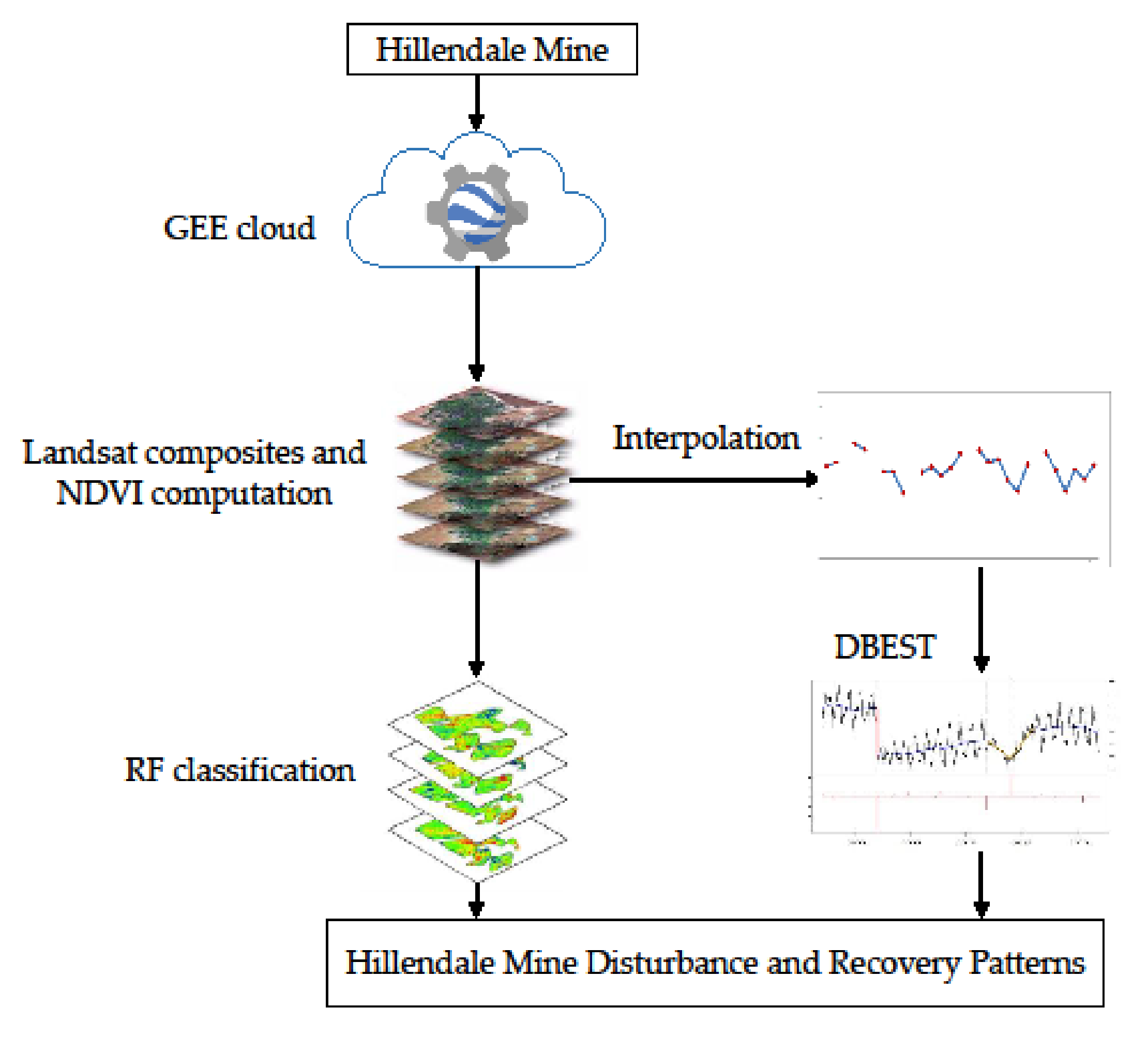
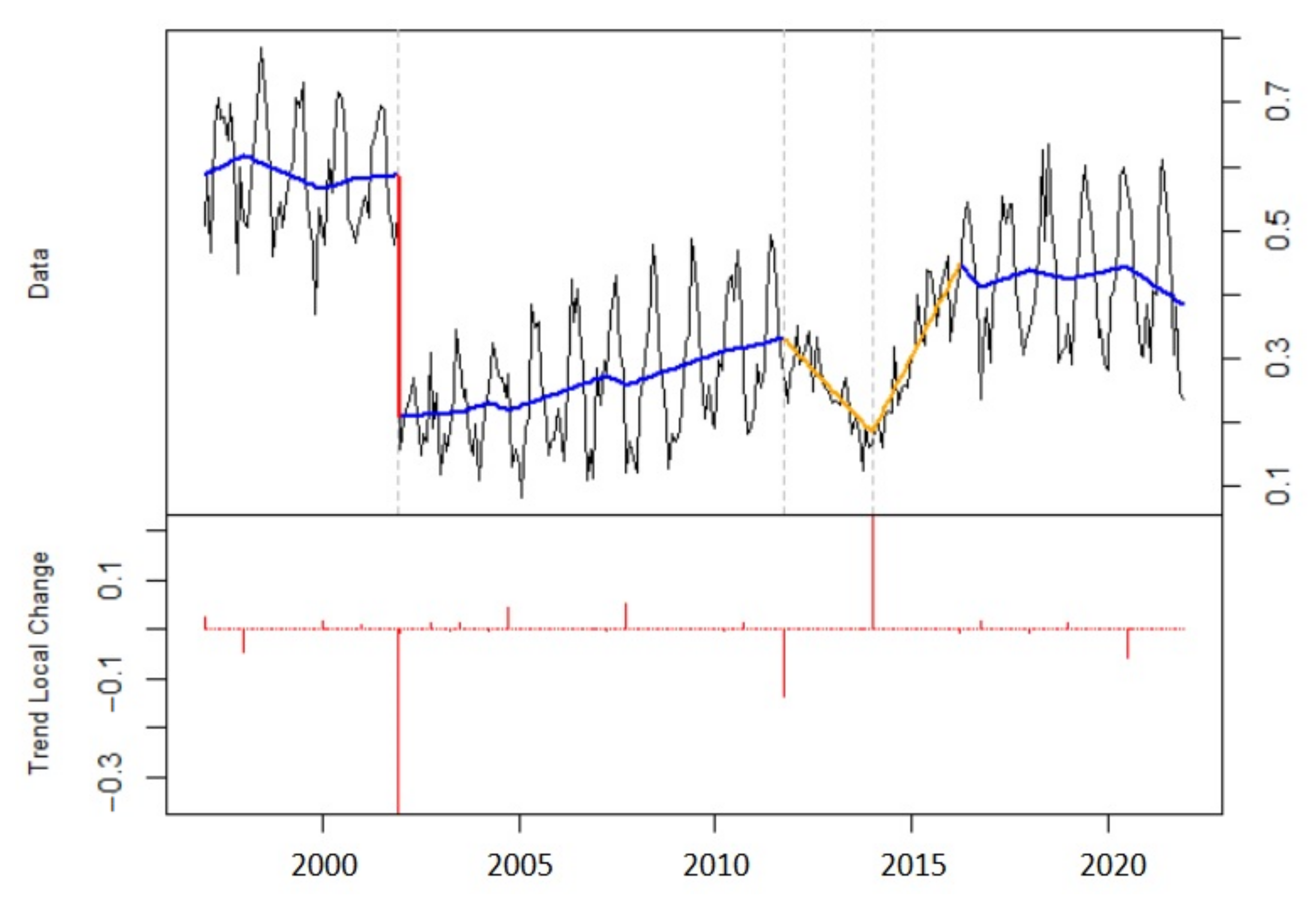
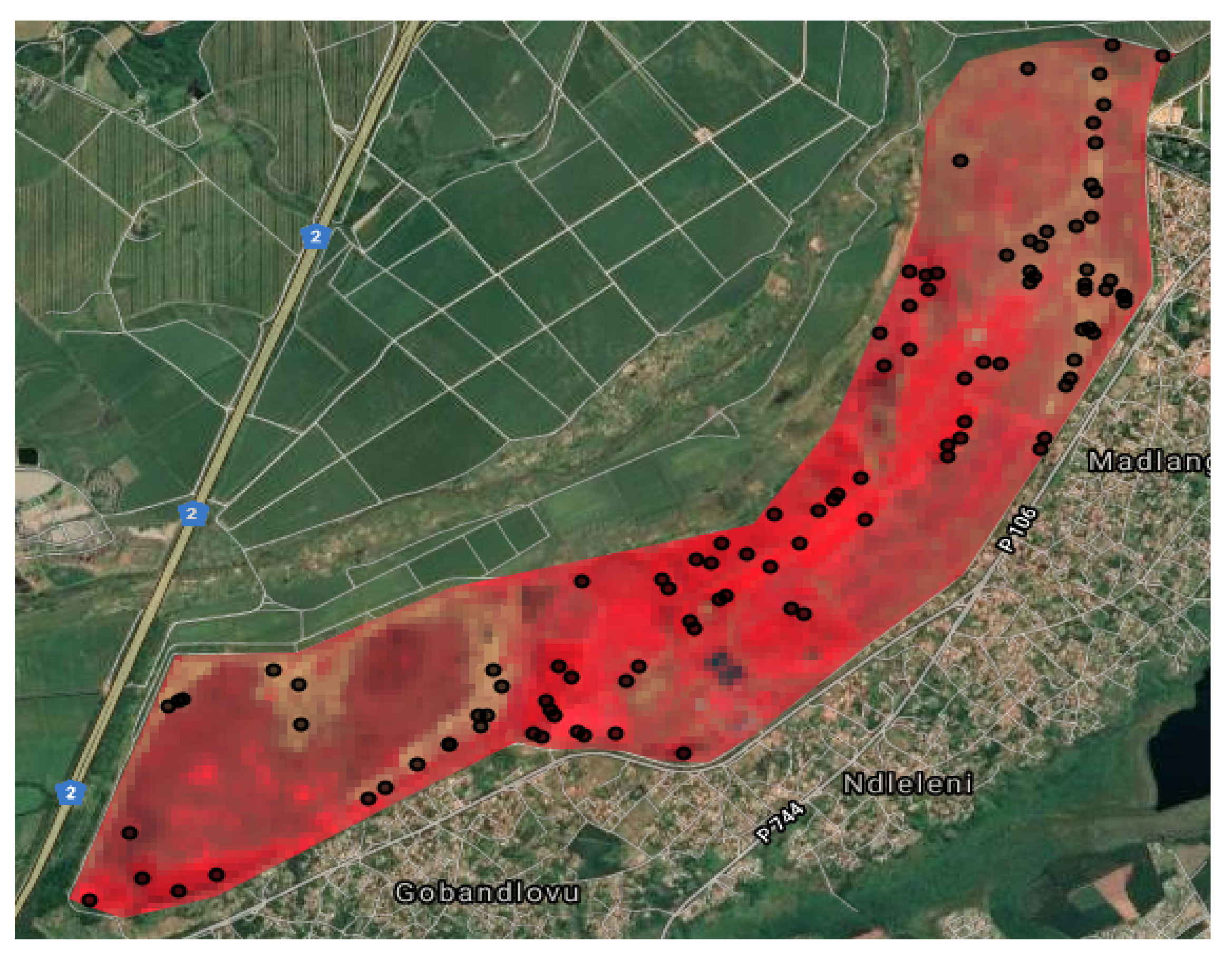
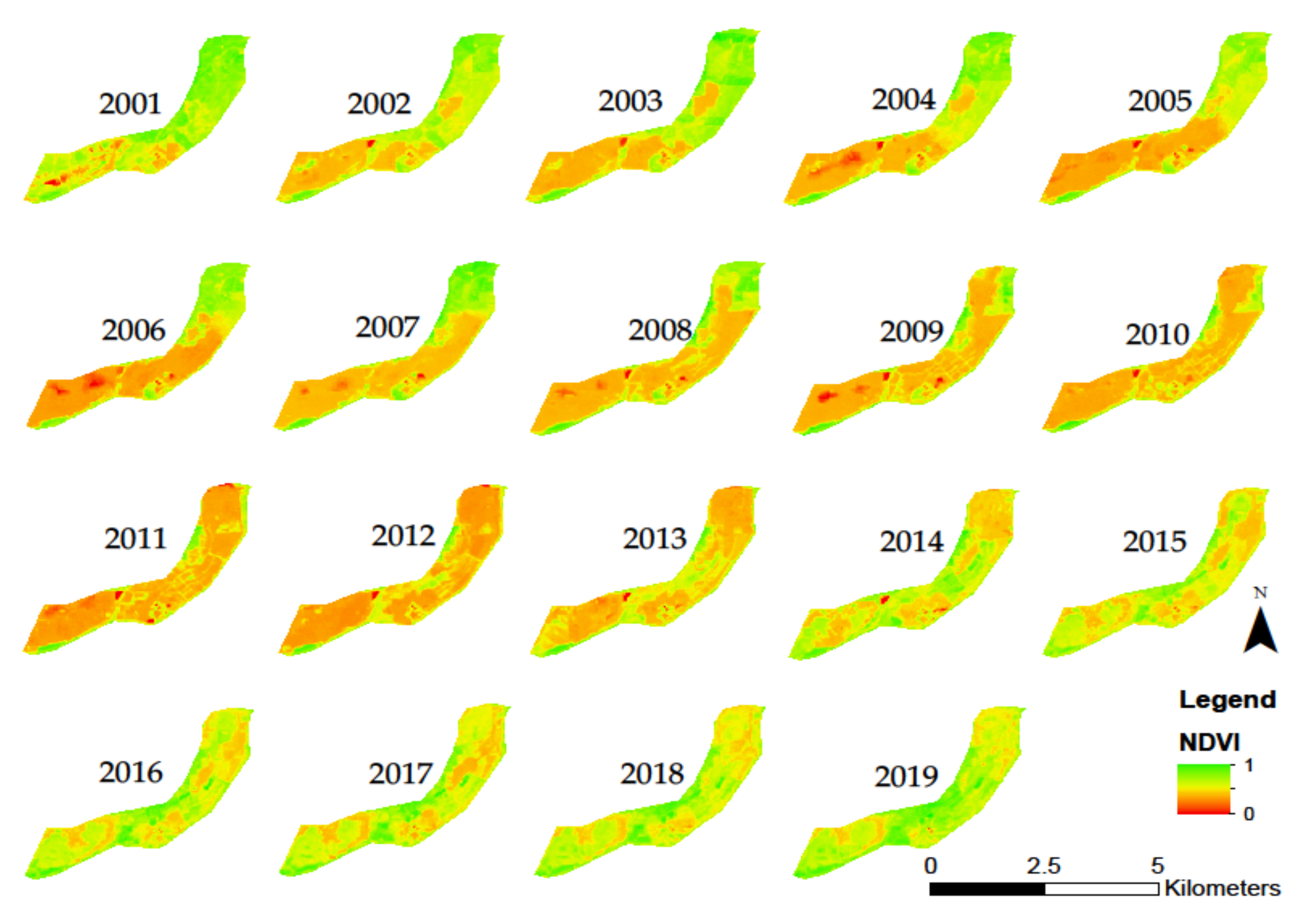
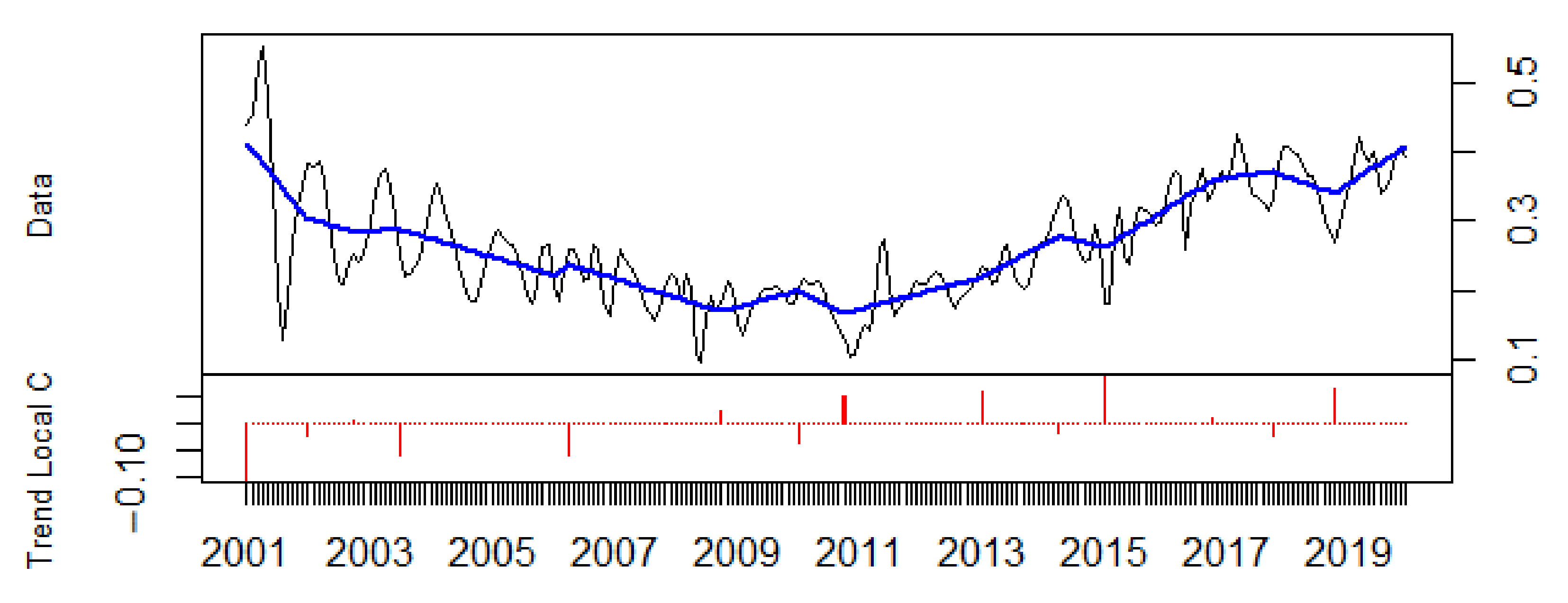
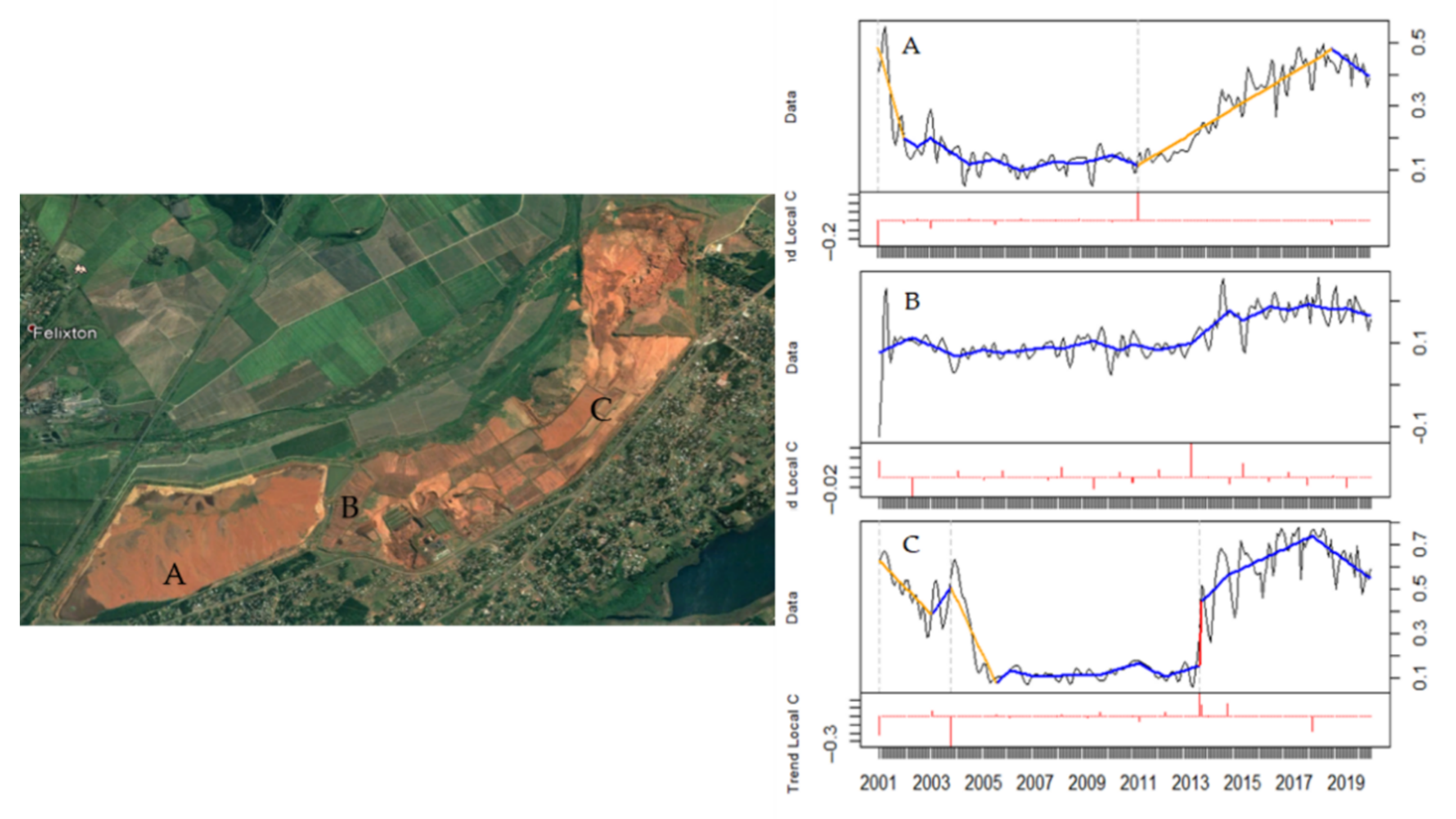
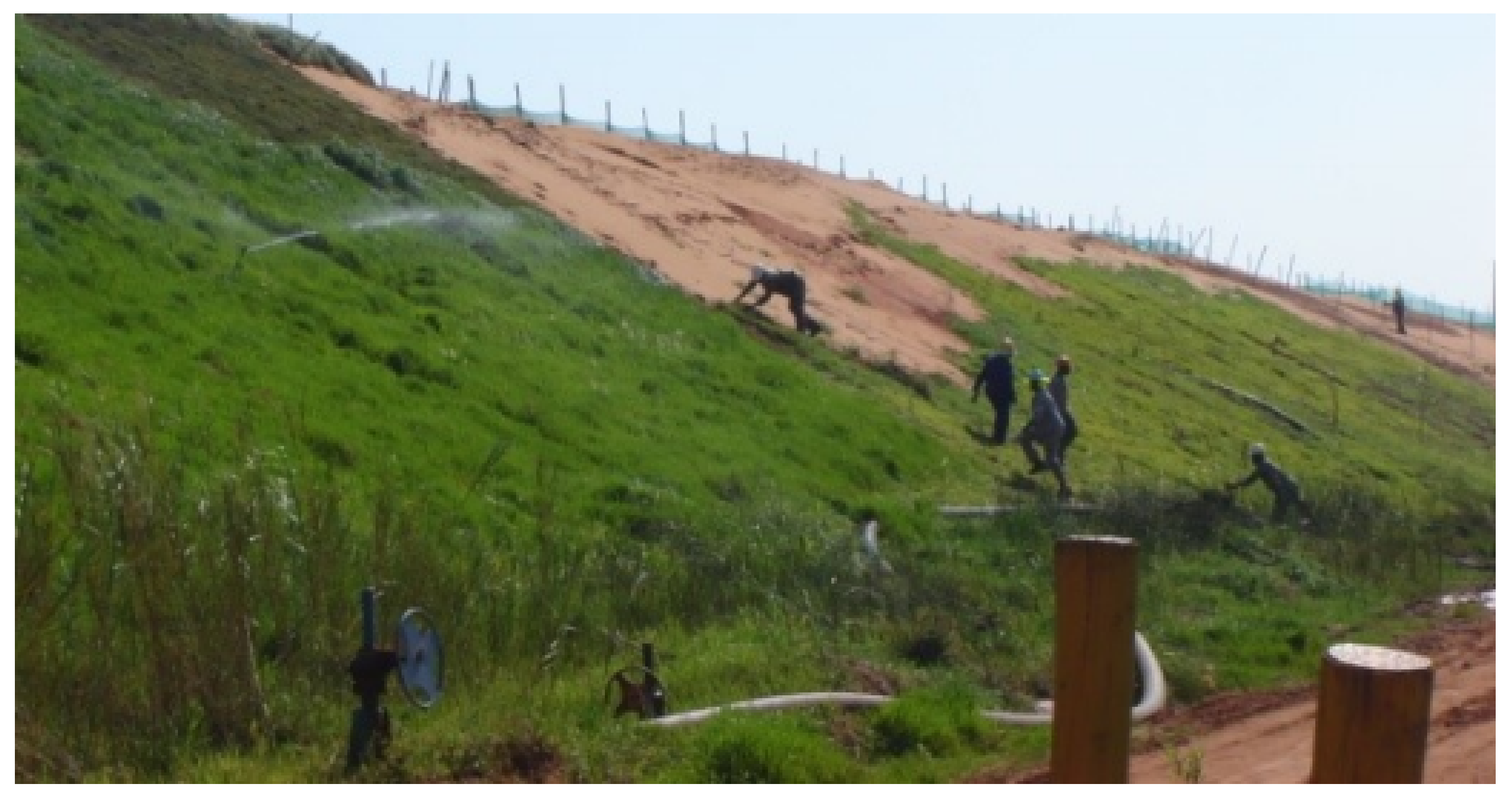
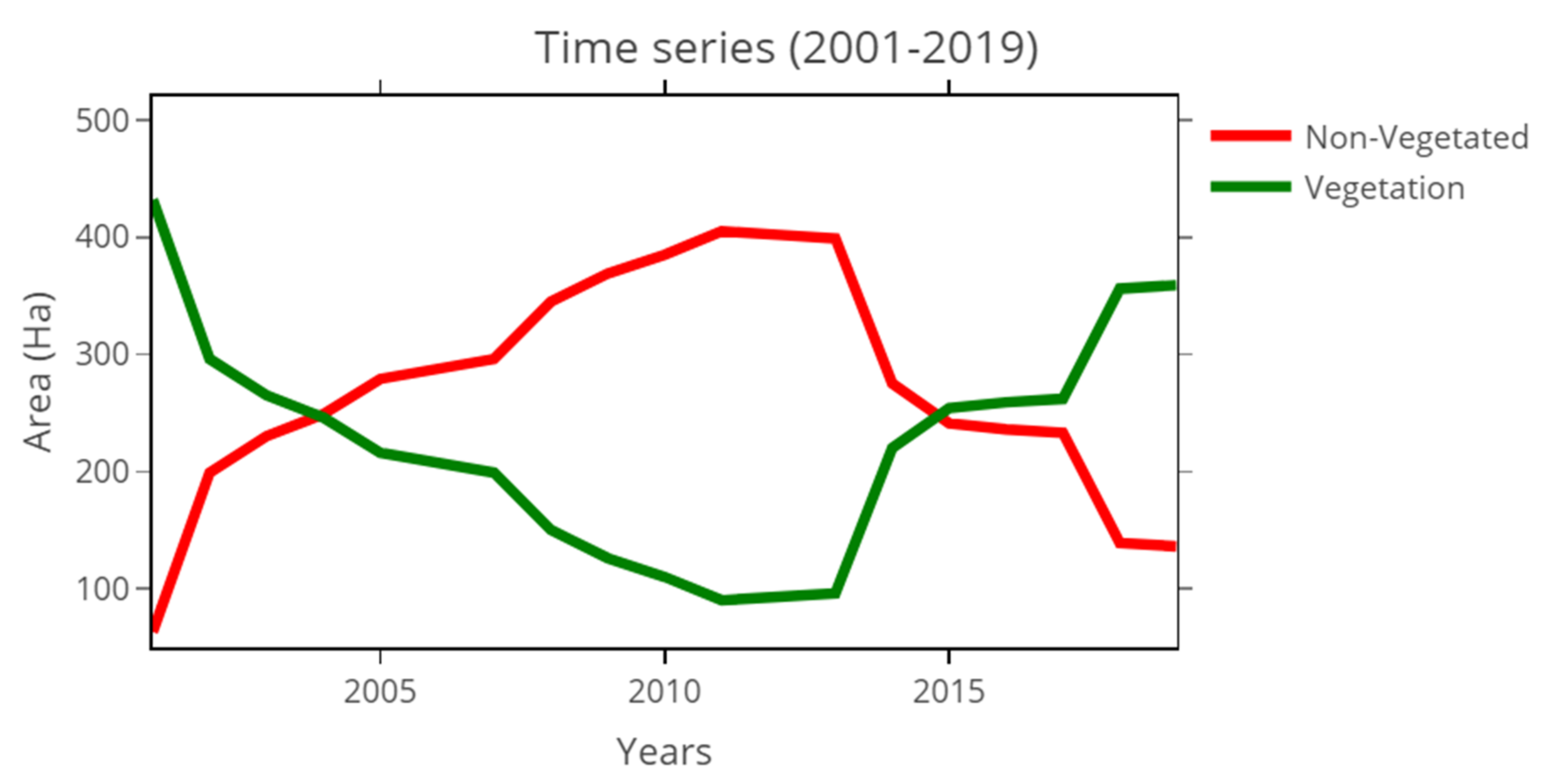
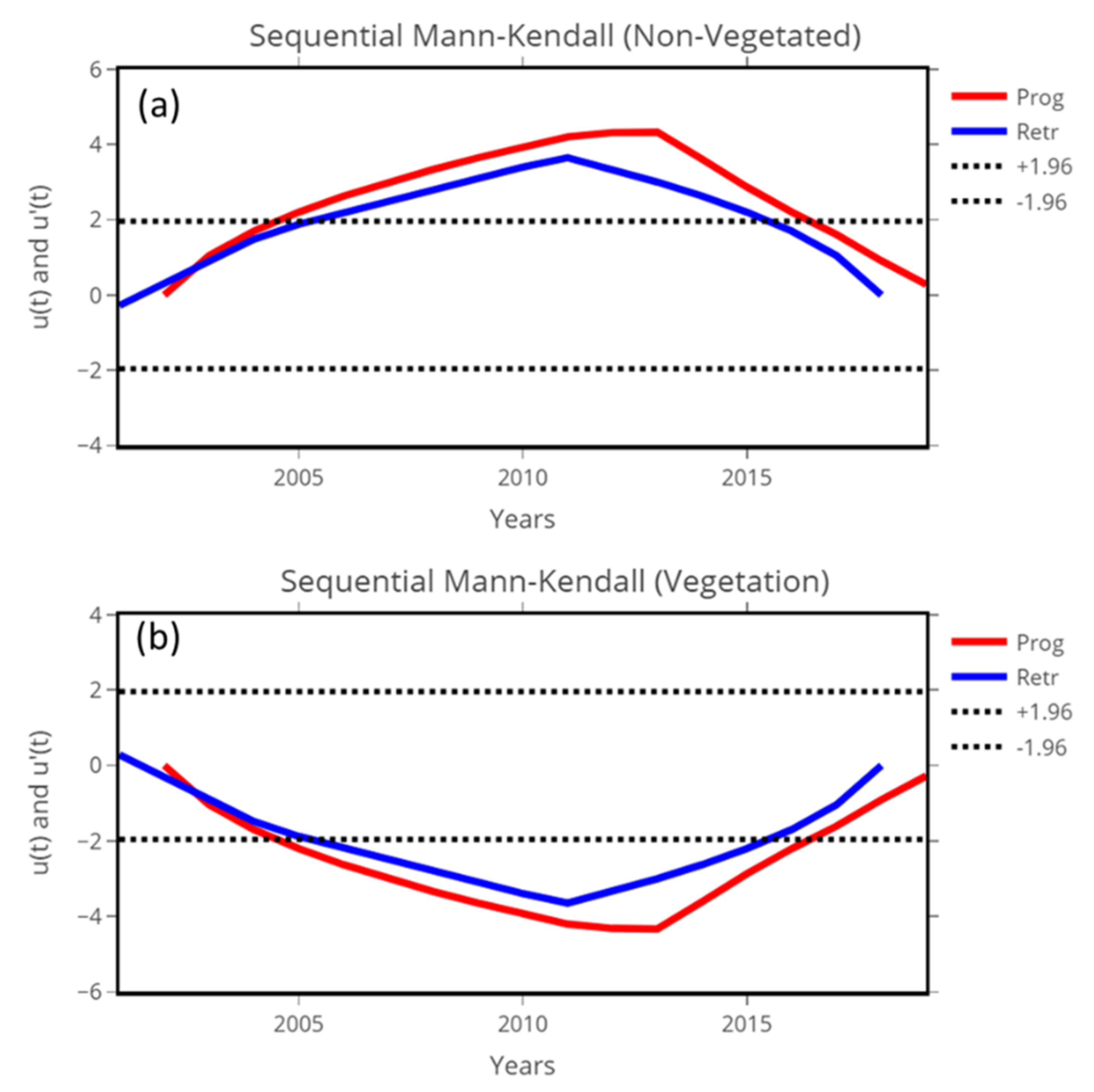
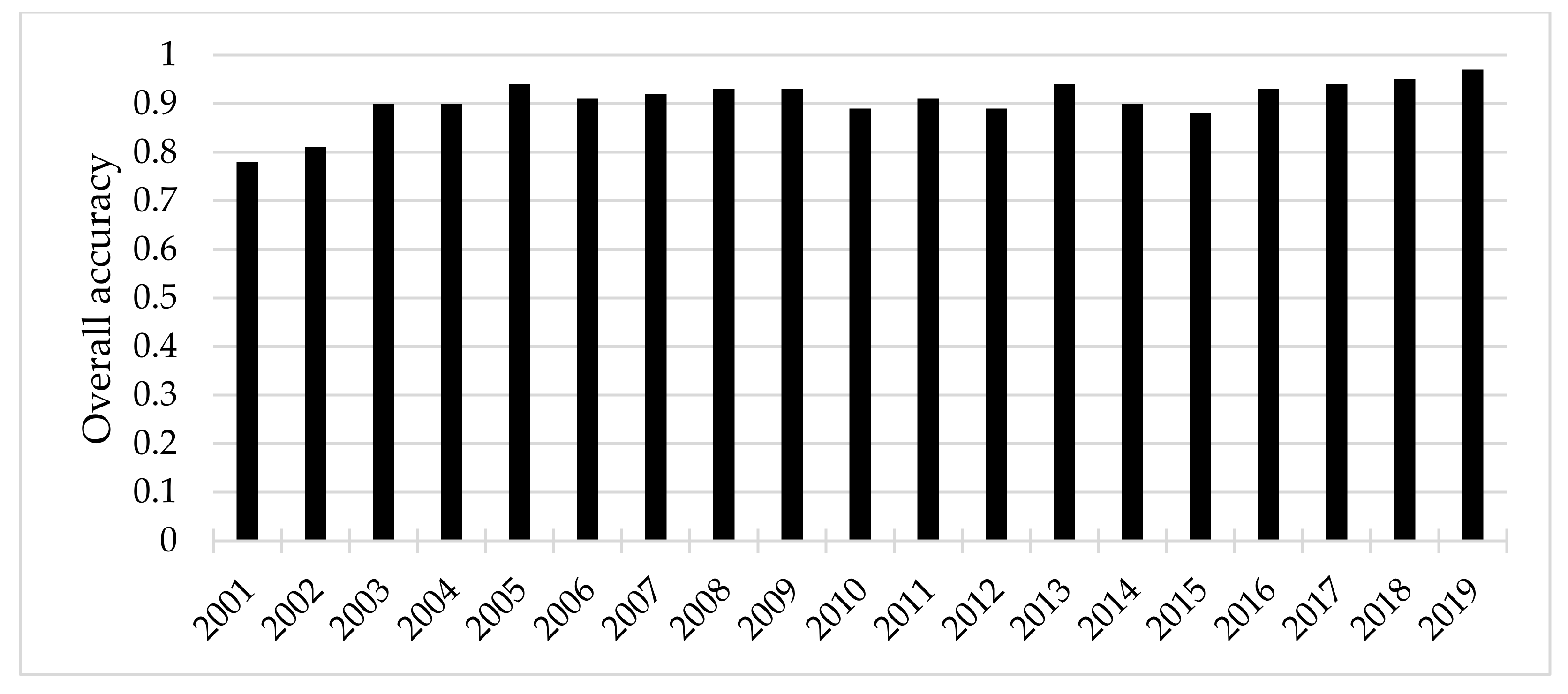
Publisher’s Note: MDPI stays neutral with regard to jurisdictional claims in published maps and institutional affiliations. |
© 2021 by the authors. Licensee MDPI, Basel, Switzerland. This article is an open access article distributed under the terms and conditions of the Creative Commons Attribution (CC BY) license (https://creativecommons.org/licenses/by/4.0/).
Share and Cite
Xulu, S.; Phungula, P.T.; Mbatha, N.; Moyo, I. Multi-Year Mapping of Disturbance and Reclamation Patterns over Tronox’s Hillendale Mine, South Africa with DBEST and Google Earth Engine. Land 2021, 10, 760. https://doi.org/10.3390/land10070760
Xulu S, Phungula PT, Mbatha N, Moyo I. Multi-Year Mapping of Disturbance and Reclamation Patterns over Tronox’s Hillendale Mine, South Africa with DBEST and Google Earth Engine. Land. 2021; 10(7):760. https://doi.org/10.3390/land10070760
Chicago/Turabian StyleXulu, Sifiso, Philani T. Phungula, Nkanyiso Mbatha, and Inocent Moyo. 2021. "Multi-Year Mapping of Disturbance and Reclamation Patterns over Tronox’s Hillendale Mine, South Africa with DBEST and Google Earth Engine" Land 10, no. 7: 760. https://doi.org/10.3390/land10070760
APA StyleXulu, S., Phungula, P. T., Mbatha, N., & Moyo, I. (2021). Multi-Year Mapping of Disturbance and Reclamation Patterns over Tronox’s Hillendale Mine, South Africa with DBEST and Google Earth Engine. Land, 10(7), 760. https://doi.org/10.3390/land10070760






